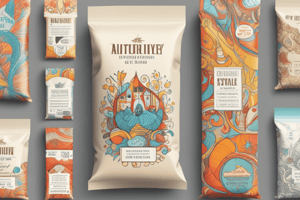Podcast
Questions and Answers
What are the main barrier materials used to protect against gas permeation in food packaging?
What are the main barrier materials used to protect against gas permeation in food packaging?
Aluminium foil, EVOH (Ethylene Vinyl Alcohol), PVdC (Polyvinylidene Chloride), aluminium metallised PET (Polyethylene Terephthalate), SiOx (Silicon Oxide) coated PET, or wax.
Why is EVOH often sandwiched between layers of PE or PP in paper-based flexible materials?
Why is EVOH often sandwiched between layers of PE or PP in paper-based flexible materials?
EVOH offers excellent gas barrier properties but deteriorates in high humidity environments, so it's often sandwiched between layers of PE or PP to provide protection.
What are the main concerns with using aluminium foil in food packaging?
What are the main concerns with using aluminium foil in food packaging?
Some end-users discourage the use of aluminium foil due to difficulties in recycling post-consumer waste management systems.
What is the purpose of a barrier to oil, grease and fat in food packaging?
What is the purpose of a barrier to oil, grease and fat in food packaging?
What barrier materials are commonly used to provide resistance to oil, grease and fat in food packaging?
What barrier materials are commonly used to provide resistance to oil, grease and fat in food packaging?
How can a thin coating of ionomer resin be used to improve the barrier properties of aluminium foil in food packaging?
How can a thin coating of ionomer resin be used to improve the barrier properties of aluminium foil in food packaging?
What are the key requirements for the packaging of dried foods like instant coffee and potato chips?
What are the key requirements for the packaging of dried foods like instant coffee and potato chips?
How do the packaging requirements differ for breakfast cereals compared to dried foods?
How do the packaging requirements differ for breakfast cereals compared to dried foods?
Explain why preventing excessive moisture retention is crucial for the packaging of cakes.
Explain why preventing excessive moisture retention is crucial for the packaging of cakes.
Describe two methods for providing low water vapor permeability in food packaging.
Describe two methods for providing low water vapor permeability in food packaging.
Explain how gas flushing and vacuum packing can help protect products like ground coffee from flavor and aroma loss or contamination.
Explain how gas flushing and vacuum packing can help protect products like ground coffee from flavor and aroma loss or contamination.
What type of packaging material provides a moderate water vapor barrier property, and how does this compare to other barrier materials?
What type of packaging material provides a moderate water vapor barrier property, and how does this compare to other barrier materials?
What are the key factors to consider when determining the type and amount of barrier material needed for product protection in paper-based flexible packaging?
What are the key factors to consider when determining the type and amount of barrier material needed for product protection in paper-based flexible packaging?
Why are different barrier materials not interchangeable in providing product protection?
Why are different barrier materials not interchangeable in providing product protection?
Give an example of a barrier material and the type of protection it offers.
Give an example of a barrier material and the type of protection it offers.
What factors influence the effectiveness of barrier materials in providing product protection?
What factors influence the effectiveness of barrier materials in providing product protection?
Why is cold sealing preferred for heat-sensitive products like chocolate in flexible packaging?
Why is cold sealing preferred for heat-sensitive products like chocolate in flexible packaging?
What is the importance of barrier properties in paper-based flexible packaging?
What is the importance of barrier properties in paper-based flexible packaging?
Flashcards
Main barrier materials
Main barrier materials
Materials used to protect food from gas permeation, including aluminium foil, EVOH, and PVdC.
EVOH in packaging
EVOH in packaging
EVOH is sandwiched between PE or PP as it has great gas barrier properties but is affected by humidity.
Aluminium foil concerns
Aluminium foil concerns
End-users may discourage aluminium foil due to recycling issues in post-consumer waste systems.
Barrier against oil and fat
Barrier against oil and fat
Signup and view all the flashcards
Materials for oil resistance
Materials for oil resistance
Signup and view all the flashcards
Ionomer resin with foil
Ionomer resin with foil
Signup and view all the flashcards
Dried foods packaging needs
Dried foods packaging needs
Signup and view all the flashcards
Breakfast cereals packaging
Breakfast cereals packaging
Signup and view all the flashcards
Cakes moisture prevention
Cakes moisture prevention
Signup and view all the flashcards
Low water vapor permeability methods
Low water vapor permeability methods
Signup and view all the flashcards
Gas flushing and vacuum packing
Gas flushing and vacuum packing
Signup and view all the flashcards
Moderate water vapor barrier
Moderate water vapor barrier
Signup and view all the flashcards
Determining barrier materials
Determining barrier materials
Signup and view all the flashcards
Interchangeability of barrier materials
Interchangeability of barrier materials
Signup and view all the flashcards
Example of barrier material
Example of barrier material
Signup and view all the flashcards
Factors influencing material effectiveness
Factors influencing material effectiveness
Signup and view all the flashcards
Cold sealing benefits
Cold sealing benefits
Signup and view all the flashcards
Importance of barrier properties
Importance of barrier properties
Signup and view all the flashcards




